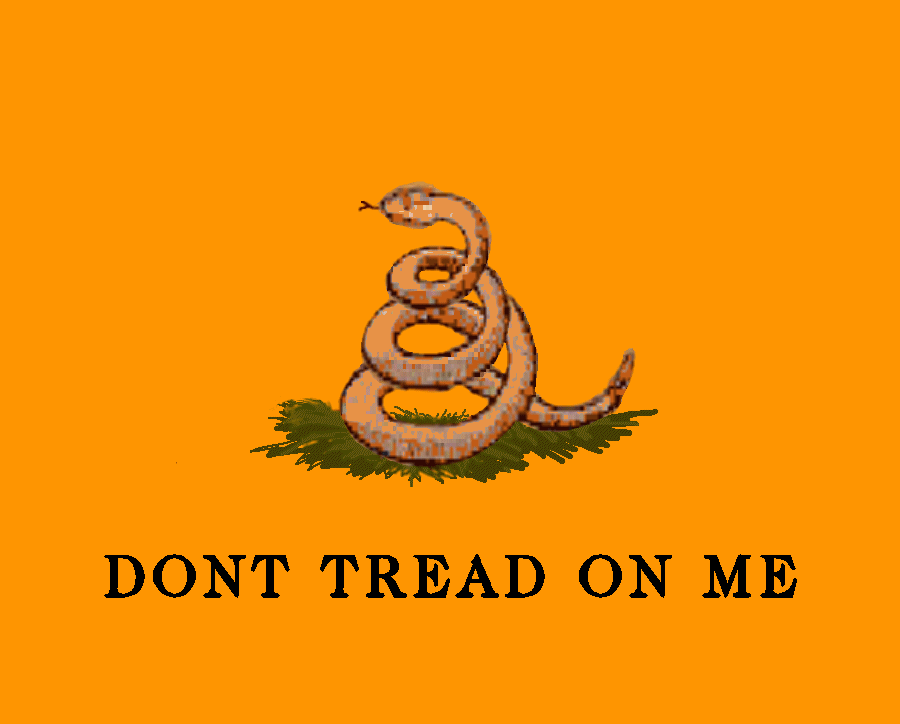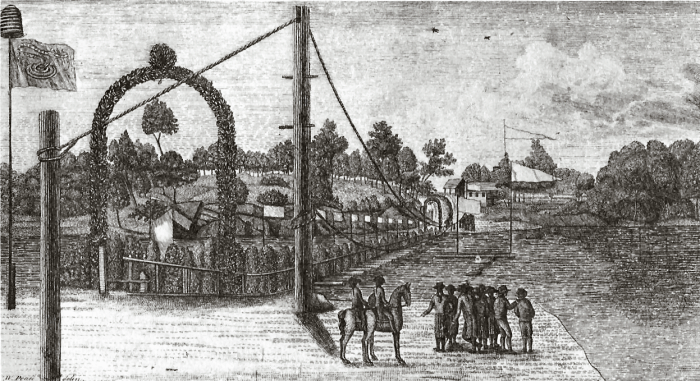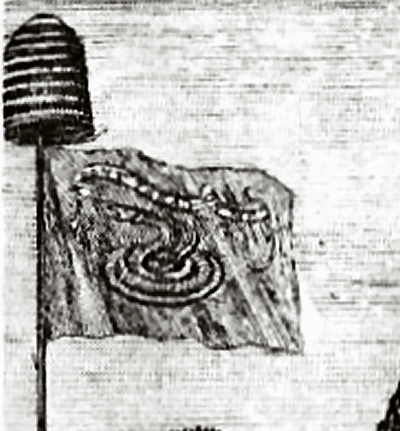


 The Standard Of The Commander-In-Chief Continental Navy was known variously, or more commonly, as the Gadsden Flag.
The Standard Of The Commander-In-Chief Continental Navy was known variously, or more commonly, as the Gadsden Flag.
 The Continental Navy was, in effect, established in October 1775 with the appointment of a committee on the 13th within the delegates meeting in the Second Continental Congress. The committee consisted of Silas Deane, John Langdon and Christopher Gadsden, whose job was to get a vessel outfitted with ten carriage guns and a number of swivels. Known variously as the Marine Committee, Naval Committee and the Board of Admiralty, the committee was enlarged, on 30 October, by the addition of John Adams, Joseph Hewes, Stephen Hopkins and Richard Henry Lee, and directed to fit out more vessels with cannon and similar armments. The frigate Alfred was prepared to serve as the flagship of the new-born naval fleet. Esek Hopkins was commissioned as the first Commander-in-Chief of the Continental Navy.
The Continental Navy was, in effect, established in October 1775 with the appointment of a committee on the 13th within the delegates meeting in the Second Continental Congress. The committee consisted of Silas Deane, John Langdon and Christopher Gadsden, whose job was to get a vessel outfitted with ten carriage guns and a number of swivels. Known variously as the Marine Committee, Naval Committee and the Board of Admiralty, the committee was enlarged, on 30 October, by the addition of John Adams, Joseph Hewes, Stephen Hopkins and Richard Henry Lee, and directed to fit out more vessels with cannon and similar armments. The frigate Alfred was prepared to serve as the flagship of the new-born naval fleet. Esek Hopkins was commissioned as the first Commander-in-Chief of the Continental Navy.
 Part of the Alfred's arsenal consisted of a number of flags to be used as signals between it and other ships in the fleet. The three signal flags which were intended to be used for a general attack was described as: the "standard at the maintopmast head with the Striped jack and ensign at their proper places." The Striped jack, variously known as the Rebel Stripes would have been a flag of thirteen alternating red and white stripes, to be flown from the ship's bow. The ensign would have been the Continental Union, a combination of the Rebel Stripes and the British Union Jack, to be flown at the ship's stern. The Alfred's Standard was noted as a flag which had a rattlesnake on a yellow field.
Part of the Alfred's arsenal consisted of a number of flags to be used as signals between it and other ships in the fleet. The three signal flags which were intended to be used for a general attack was described as: the "standard at the maintopmast head with the Striped jack and ensign at their proper places." The Striped jack, variously known as the Rebel Stripes would have been a flag of thirteen alternating red and white stripes, to be flown from the ship's bow. The ensign would have been the Continental Union, a combination of the Rebel Stripes and the British Union Jack, to be flown at the ship's stern. The Alfred's Standard was noted as a flag which had a rattlesnake on a yellow field.
 No original for the Standard Of The Commander-In-Chief Continental Navy exists today. The design that has become accepted, and which is used for the illustration above, was created by B.J. Lossing for his 1849 publication, The Pictorial Field-Book Of The Revolution. There is no proof that the motto (Dont Tread On Me) was painted on the original flag flown on the Alfred's maintopmast in 1775.
No original for the Standard Of The Commander-In-Chief Continental Navy exists today. The design that has become accepted, and which is used for the illustration above, was created by B.J. Lossing for his 1849 publication, The Pictorial Field-Book Of The Revolution. There is no proof that the motto (Dont Tread On Me) was painted on the original flag flown on the Alfred's maintopmast in 1775.
 Christopher Gadsden is credited with creating the design for this flag. Gadsden is believed to have participated in the South Carolina Sons Of Liberty. At the outset of the American Revolutionary War period, Gadsden was sent by the South Carolina Provincial Congress as a delegate to the Second Continental Congress. Having been chosen to participate on the committee to oversee naval affairs, Christopher Gadsden served on the Naval / Marine Committee as its chairman until 14 January 1776. At that time, Gadsden was recalled to South Carolina. On his return on 09 February, Gadsden presented a flag to the South Carolina Provincial Congress, meeting in Charleston. The entry from the South Carolina Congress' Journal notes the rattlesnake design with the motto, Don't Tread On Me, but it did not specifically state that Gadsden himself created the design. It might have been a committee decision, but as is usually the case in a committee decision, the chairman's name becomes attached to the item. The flag therefore has come to be known as The Gadsden Flag.
Christopher Gadsden is credited with creating the design for this flag. Gadsden is believed to have participated in the South Carolina Sons Of Liberty. At the outset of the American Revolutionary War period, Gadsden was sent by the South Carolina Provincial Congress as a delegate to the Second Continental Congress. Having been chosen to participate on the committee to oversee naval affairs, Christopher Gadsden served on the Naval / Marine Committee as its chairman until 14 January 1776. At that time, Gadsden was recalled to South Carolina. On his return on 09 February, Gadsden presented a flag to the South Carolina Provincial Congress, meeting in Charleston. The entry from the South Carolina Congress' Journal notes the rattlesnake design with the motto, Don't Tread On Me, but it did not specifically state that Gadsden himself created the design. It might have been a committee decision, but as is usually the case in a committee decision, the chairman's name becomes attached to the item. The flag therefore has come to be known as The Gadsden Flag.
 The Gadsden Flag was depicted in the etching below. The coiled rattlesnake on a plain field, wth the motto "Don't Tread on Me" is shown at the top of a Liberty Pole.
The Gadsden Flag was depicted in the etching below. The coiled rattlesnake on a plain field, wth the motto "Don't Tread on Me" is shown at the top of a Liberty Pole.

An East View of Gray's Ferry, near Philadelphia, with the Triumphal Arches, &c. erected for the Reception of General Washington, April 20th 1789
C.W. Peale delin. J[ames] Trenchard Sculp.
Etching.
This image maintained by the Library Of Congress

Detail.
 Although not the official standard of the United States Marine Corps, the Gadsden Flag has come to be acknowledged by many members of the United States Marine Corps as its first standard.
Although not the official standard of the United States Marine Corps, the Gadsden Flag has come to be acknowledged by many members of the United States Marine Corps as its first standard.
 It should be noted that the so-called Gadsden Flag was not actually the first ensign to be flown from a ship of the Continental naval fleet, according to B.J. Lossing. In the supplement to Volume II of his Pictorial History..., Lossing stated that: "The first ensign ever shown by a regular American man-of-war was raised on board the Alfred, in the Delaware, in December 1775 by the hands of John Paul Jones, then Hopkins's first lieutenant. This flag, according to a portrait of Hopkins's published in London in 1776, was a plain ground, with a pine-tree in the center. At the top were the words Liberty Tree, and at the bottom, Appeal to God. The Union flag with thirteen stripes, adopted by the army on the first of January 1776, was also displayed. This had a representation of a rattle-snake, with the words Don't tread on me"
It should be noted that the so-called Gadsden Flag was not actually the first ensign to be flown from a ship of the Continental naval fleet, according to B.J. Lossing. In the supplement to Volume II of his Pictorial History..., Lossing stated that: "The first ensign ever shown by a regular American man-of-war was raised on board the Alfred, in the Delaware, in December 1775 by the hands of John Paul Jones, then Hopkins's first lieutenant. This flag, according to a portrait of Hopkins's published in London in 1776, was a plain ground, with a pine-tree in the center. At the top were the words Liberty Tree, and at the bottom, Appeal to God. The Union flag with thirteen stripes, adopted by the army on the first of January 1776, was also displayed. This had a representation of a rattle-snake, with the words Don't tread on me"

